

When applying any type of massage stroke, begin superficially, or close to the surface, and gradually sink in deeper as you perform repetitions. This gives the body an opportunity to warm up and allow deeper access as both the receiver and the particular muscle accept increasing depth of strokes. Start with broad strokes, generally using the whole hand or forearm, and gradually work more specifically, using fingers. This also allows the tissue to warm up and accept smaller and more targeted pressure.
In general, apply between three and six strokes to give your partner a chance to relax into what you’re doing without becoming annoyed by it. Using more than ten strokes of the same kind would probably irritate her.
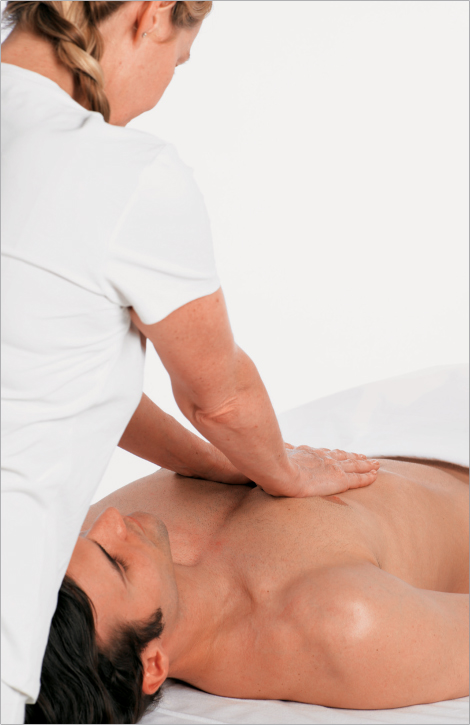
Effleurage—using the flat palm with fingers together, you glide away from your torso with neutral (not flexed or hyperextended) wrists. Effleurage strokes may be performed with one or both hands, or with forearms in some areas of the body
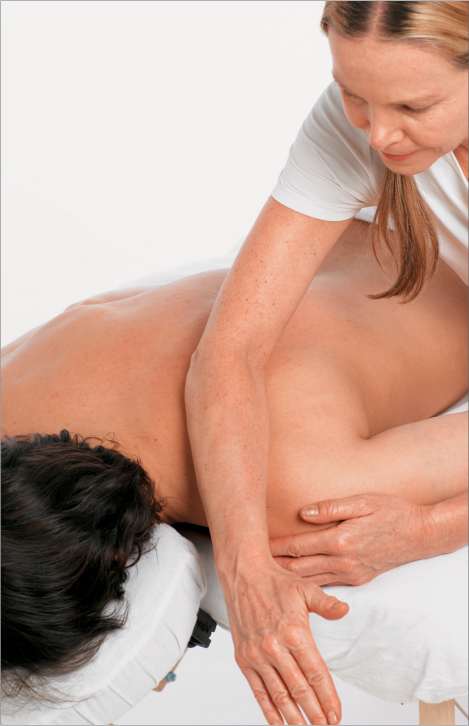
Pushing strokes—Alternating effleurage with the backs of fingers and the palms
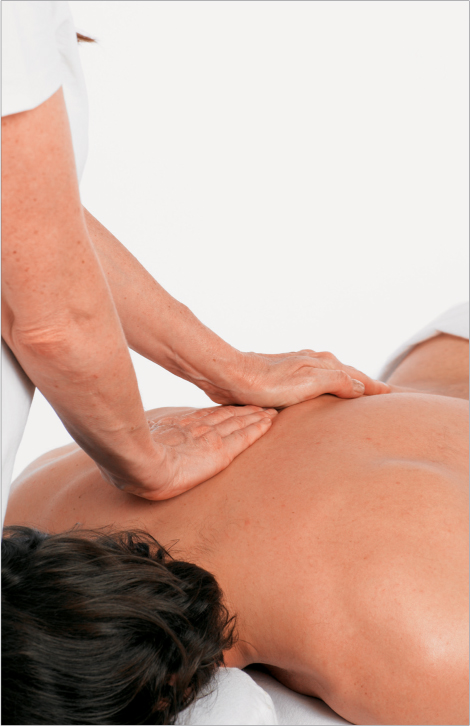
Friction—Small circles or short back-and-forth movements applied with the fingers
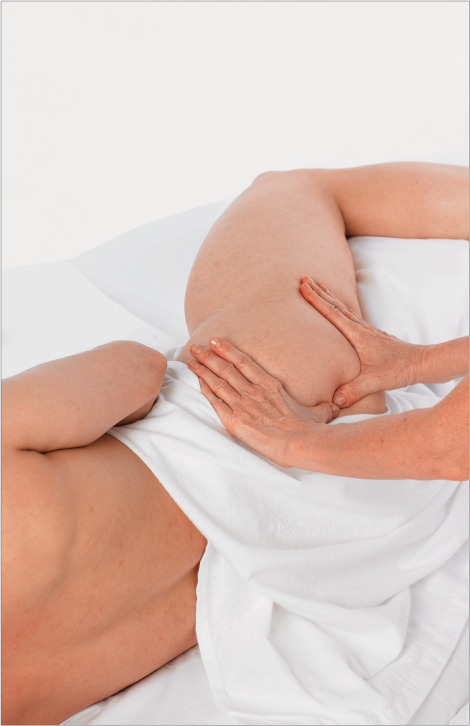
Stripping—Short friction strokes applied unidirectionally
Petrissage—Kneading, lifting, and squeezing muscle tissue with the palm in full contact with the skin
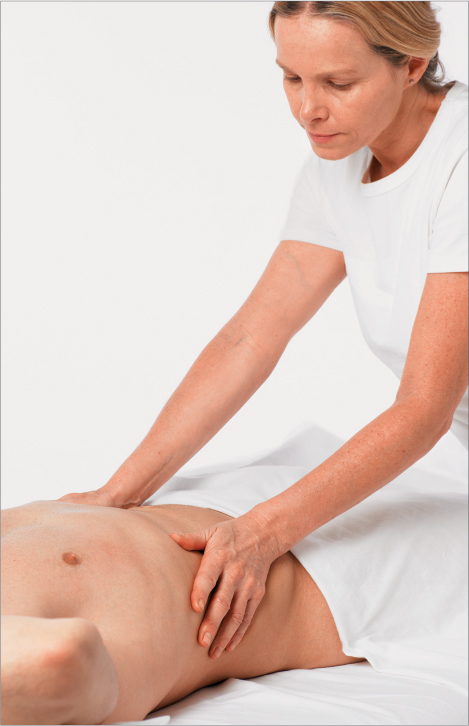
Spreading—A type of effleurage stroke in which the hands move apart to stretch the skin and underlying muscles
Compression—Pressing downward into the tissue with fingers, thumbs, or forearm, or sqeezing the tissue with static pressure between fingers and heel of hand
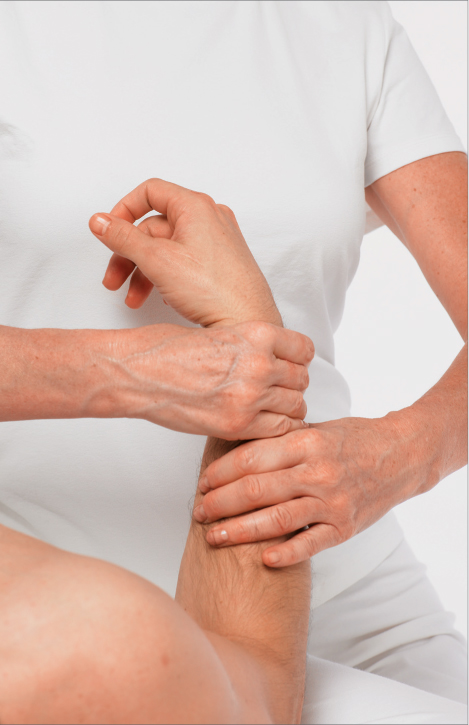
Wringing—Grasping an area, usually of a limb, and working your hands in opposition to each other, as if wringing water out of a towel
Tapotement—Brisk percussive movements performed in a rapid, rhythmic fashion
There is a difference between depth and pressure. Many techniques that use stretching or energy manipulation can have a very deep and therapeutic effect without the application of a lot of pressure. Massaging with finesse rather than force is generally preferable, for both the giver and the receiver. In all forms of massage, it is preferable to use gradual penetration into deeper layers of the body, waiting for the tissue to “invite” you in. Pushing through resistance is often painful and can cause lingering discomfort and injury. The deeper you intend to work, the slower you must perform compressions or strokes, or the body will resist and the receiver will experience pain. If you feel a strong pulse under your fingers or hand, especially at the neck, groin, or abdomen, you have two choices: Lighten your pressure until you do not feel the pulse or move your hand to a location where the pulse is not present. When massaging slim, narrow-hipped people, you may find there is nowhere on the abdomen you do not feel a strong pulse; go lightly or skip the abdominal massage.
When performing range-of-motion techniques, feel for end points, or points where the movement slows and meets restriction. It is imperative that you move a limb or other area of the body through its range of motion very slowly, as it is difficult to detect “end feel” when you are moving the body too quickly, and you can exceed the comfortable and normal range before you are aware you have reached the joint’s limitation. You should seek to encourage a limb to very gradually move a little farther into its range of motion, rather than apply any force. When in doubt, slow is always preferable to fast when it comes to bodywork, although if your partner is preparing for an athletic event, doing faster massage will have a stimulating preparatory effect.
There are some guidelines for how long to hold compressions, mostly in terms of the approximate number of breaths, but what is most important is that you focus on your partner’s response to what you are doing and respond to that rather than go through some arbitrary rote routine. That being said, avoid repeating a stroke more than a dozen times, as it can become tedious and irritating; also avoid changing strokes before your partner’s nervous system has a chance to relax into what’s happening. Somewhere around three to five repetitions of most strokes is ideal, although you may find areas of your partner’s body where it just feels right to perform more or less.
In this section, you’ll find a helpful review of directional terms as well as diagrams showing the locations of many of the muscles and bones discussed in the step-by-step techniques described in this book. You will find the definitions of additional terms in the Glossary section, beginning on page 235.
Anterior—Front of the body
Posterior—Back of the body
Dorsal—Back of the hand, forearm, or foot
Ventral—Palm of the hand, sole of the foot
Lateral—A relational term; farther from the midline of the body
Medial—A relational term; closer to the midline of the body
Superior—A relational term; closer to the top of the body, or the head
Inferior—A relational term; closer to the bottom of the body, or the feet)
Supine—Face up
Prone—Face down
Supinated—Palms facing up
Pronated—Palms facing down
Maximum comfort is key for massage to be pleasant and effective for relaxation and stress relief. Your partner should feel comfortable, at ease, and secure in the room you chose for massage. A small room is both cozy and easier to heat, although your room choice will be limited by the amount of space available to you. Generally, a room between 72°F and 74°F (22°C and 23°C) will provide enough warmth for the receiver while not overheating the active giver too much. Covering is useful for all forms of massage. Some forms of massage, such as Swedish, hot stone, and lomi lomi, require direct access to the skin, so draping with a sheet or bath towel provides comfort. Cotton or cotton flannel sheets are preferable to synthetic fabric blends. Other forms such as shiatsu, Thai, Tantsu, and polarity are generally performed on a clothed receiver, who should be dressed in comfortable, loose, preferably cotton garments.
Your own clothing should be loose enough to allow you to move freely but not so loose that it drags across your partner’s body. Likewise, your hair should be out of the way so that you don’t have to keep sweeping it from your face and pulled back so that it does not touch your partner’s body. If you tend to sweat when you are exerting yourself, having a hand towel nearby to wipe your face or wearing a headband to catch perspiration before it drips onto your partner will be helpful. Massage is a very physical activity, and the room you will massage in should be warm.
Indirect, low lighting or natural filtered sunlight is more relaxing than bright overhead lights; such lighting creates a more serene mood and it won’t be shining in your partner’s eyes when she is face up (supine). If your partner lacks body confidence, low lighting can be reassuring. Candles can produce an inviting and intimate environment. Quiet, soothing music is a pleasant addition to massage, but you may want to make sure you key into the rhythm of your partner’s breath rather than the music’s rhythm for some modalities, such as Thai and Tantsu. Lomi lomi, being vigorous and faster-paced, lends itself to somewhat faster music with a pronounced beat (or Hawaiian music, which will remind you to hula!), while the relaxation in Swedish and hot stone massages is enhanced by slow music.
Create a space for massage where you can have room to spread out. Whether you are using a massage table or a mat, it is useful to have at least 3 feet (91.4 cm) of space around the perimeter for a chair, stool, or cushion and room to extend your own body when necessary to avoid awkward positioning. You may not have space in your home to devote a full-time area to massage, so a folding portable massage table or floor mat will serve you well. When selecting a massage table, make sure it is sturdy and is rated for the heaviest person you will likely massage, including your own weight if you are likely to get up on the table to perform some actions, as in the table adaptations for Thai massage. Folding massage tables set up quickly and are easily carried and stored in a closet or under the bed.
A regular chair or stool works well for portions of a table massage when you will be seated to massage your partner’s head, face, and neck or feet. Experiment with different heights by adding a cushion to the seat of a chair that feels too low, for instance.
Mats are very portable and usually roll to a smaller size than a massage table for storage. A mat should be at least 60” x 80” (1.5 x 2 m) and may include a supplemental kneeling pad; if it doesn’t, you can substitute a flat cushion. Mats marketed primarily for Thai massage work fine for all the mat-based techniques in this book. You can use a sheet or blanket to cover the mat surface for massage or purchase a mat with a removable cover; otherwise, the mat will become unpleasant after much use. (You can find sources for massage tables and floor mats in the Resources section at the end of this book.) Have a few cushions close at hand for massage on a table or a floor mat. A cushion to bolster your partner’s knees when she is in the face-up (supine) position takes pressure off her lower back. A cushion under her ankles when she is face down makes her ankles and calves more comfortable. A cushion under her head when she is lying on her side and another for between her knees and ankles will keep her joints neutral and padded; an additional cushion to support her upper arm is also helpful. Some individuals get congested when laying flat on their back, so a cushion under your partner’s head when she is in the supine position is welcome.
A face cradle or towel rolled to simulate a face cradle is essential for face-down or prone massage. Traditionally, people just turned their heads to the left or right, but it is much more comfortable to have the neck in a neutral position and safer for the person receiving the massage. Most massage tables come with a face cradle, and one floor-mat system includes a face cradle for floor use.
Lomi lomi is the “juiciest” modality in this book and traditionally requires a generous application of oil, while Swedish massage is best done with more sparing use of lubricant, and hot stone massage requires a moderate amount of lubricant. The purpose of a lubricant is to reduce friction on the skin, allowing your hands or stones to glide.
Lubricants can be liquid in the form of lotions, creams, or oils, either commercial products or simple vegetable oil. Some people are allergic to nut oils; peanut oil and coconut oils are particularly allergenic. If your partner is not sensitive to nuts, almond oil is a nice choice. Baby oil is mineral oil, which clogs pores and strips fat-soluble vitamins from the body, so avoid using it. Professional-quality lubricants in cream or lotion form have the benefit of better absorption than oil, with similar workability.
Besides the oil and corn starch found at grocery stores, you can find lubricants in health food stores, drugstores, and cosmetic supply shops. Professional massage lubricants can be ordered from suppliers listed in the Resources section, and you may want to find out from a local massage therapist or massage school what brands and formulations they use. Many companies are offering natural and organic lubricants in response to demand for these products.
Even though in some of the massage forms detailed in this book the receiver is dressed, making lubricant unnecessary, you don’t need to be a purist. You may add some lubricant on dry hands or feet as you feel will be beneficial. Your own hands need to be well maintained and smooth, with short nails; the lubricant you use for massage may be a good choice to use as a regular hand cream.
Never, ever assume that because you like certain massage strokes or a certain amount of pressure or pace, your partner will enjoy the same things. It is very important to receive feedback from your partner while you are performing massage. You can guess that pressure was too hard if your partner grimaces, holds her breath, or clenches her fists, but ask anyway; perhaps the stroke would be fine if you performed it more slowly. When you are receiving massage it is effective to say, “It would feel better if you did …” and then to state the change you’re seeking—slower, lighter, deeper, and so forth—than to say “Ouch, that hurts!” or similar statements. Be constructive in your feedback and gracious in accepting feedback. After all, you probably would like your partner to give you more massages and ones that increasingly are in line with your preferences.